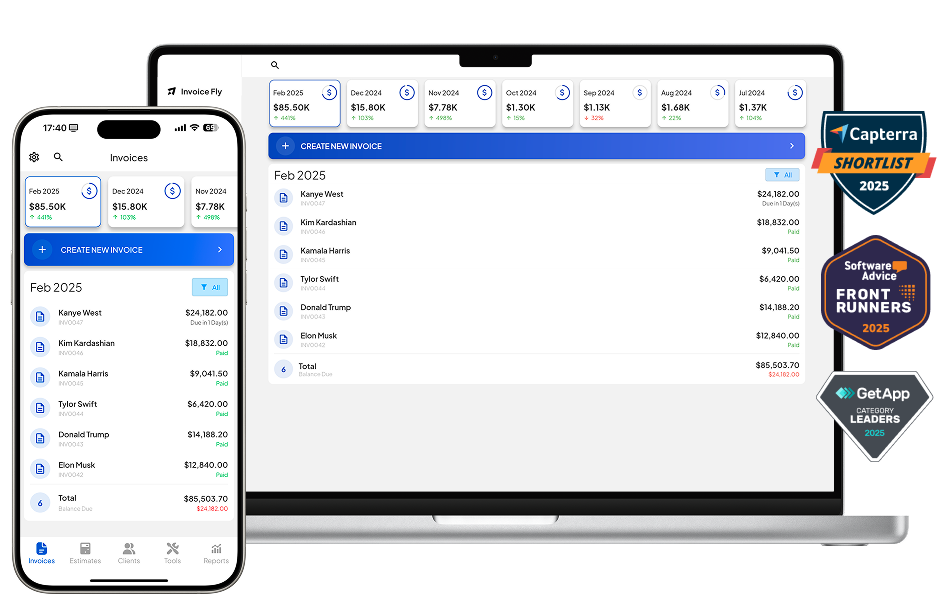- Home
- »
- Glossary Of Terms
- »
- Invoice Number
Invoice Number
An invoice number is a unique reference code assigned to each invoice issued by a business. It serves as an identifier for record-keeping, payment tracking, and communication between vendors, customers, and accountants. Each invoice number must be unique to prevent confusion and ensure accurate financial reporting.
Why invoice numbers matter
- Legal & compliance: Many jurisdictions require invoices to carry a unique identifier for audits and tax filings.
- Tracking & organization: Helps businesses locate specific transactions quickly.
- Payments: Customers use invoice numbers as payment references when paying via bank transfer, credit card, or check.
- Customer support: Streamlines communication by referencing a single number instead of multiple transaction details.
Invoice number formats
There is no global standard format; businesses can design numbering systems that fit their workflow. Common formats include:
- Sequential numbers: 001, 002, 003 …
- Date-based: INV-2025-03-001 (year-month-sequence)
- Customer-specific: CUST1001-2025-01
- Project or PO reference: PO-5678-INV-001
Best practice: avoid restarting invoice sequences mid-year, and always ensure each invoice has a unique, traceable identifier.
Examples of invoice numbers
Here are sample invoice numbers businesses might use:
INV-0001232025-03-15-045(date + sequential)NYC-CUST105-INV78(location + client + sequence)
Best practices for assigning invoice numbers
- Keep invoice numbers unique and sequential.
- Avoid overly long or complex formats (6–12 digits or alphanumeric is standard).
- Include optional prefixes like INV, client codes, or project codes for clarity.
- Use accounting or invoicing software (e.g., InvoiceFly) to auto-generate consistent invoice IDs.
- Do not reuse invoice numbers—even for canceled invoices, mark them as void instead.
Invoice numbers in different contexts
- Bank payments: Used as payment reference for wire transfers and checks.
- E-commerce & mobile: Linked to order IDs, shipment references, or digital receipts.
- Tax invoices: Required in VAT/GST countries for compliance.
- Exports: Often paired with commercial invoices for customs clearance.

FAQs Invoice Number
An invoice number is a unique reference code assigned to every invoice a business issues. It ensures that each transaction can be easily tracked, recorded in accounting systems, and referenced by both the vendor and the customer during payments, audits, or support queries.
You can usually find the invoice number at the top of the invoice document, near the header, labeled as “Invoice Number” or “Invoice ID.” It often appears next to the invoice date and customer details. In digital invoices or mobile apps, it’s typically included in the billing summary or email subject line.
You can generate invoice numbers manually using a sequential system (e.g., 001, 002, 003) or by adding prefixes like dates, customer codes, or project references. For example, INV-2025-003. Most businesses use invoicing software (such as InvoiceFly) to automatically generate unique invoice numbers to avoid duplication.
Examples include:
- INV-000123 (simple sequential with prefix)
- 2025-03-15-045 (date-based format)
- CUST101-NYC-INV34 (customer code + location + sequence)
If an invoice doesn’t have a number, it can create confusion for both customer and vendor. Missing invoice numbers may cause issues with tax compliance, bookkeeping, and payment tracking. Businesses should always include one. If you receive an invoice without a number, request a revised version from the vendor.
To create an invoice:
- Use a template or invoicing software (like Invoice Fly).
- Add your business and customer details.
- Assign a unique invoice number.
- Include the invoice date, due date, and purchase order (if any).
- List products or services with quantities, rates, and tax.
- State payment terms and options.
- Send digitally or in print.
Yes. An invoice number is required in most jurisdictions for tax and compliance reasons. It also prevents confusion when managing multiple invoices and ensures every transaction has a unique identifier for payment and record-keeping.
An invoice is a commercial document issued by a seller to a buyer, listing products or services delivered, the amount owed, payment terms, and a unique invoice number. It serves as both a payment request and a legal record of the transaction.
The invoice number is created by the seller or vendor issuing the invoice. In most cases, it is auto-generated by the business’s invoicing or accounting system.
The supplier, service provider, or vendor gives the invoice number when they issue the invoice to the customer.
An invoice is provided by the business or service provider that delivers goods or services, requesting payment from the customer.
There is no fixed rule, but invoice numbers usually range between 6 and 12 characters for clarity. They can be purely numeric (e.g., 100245) or alphanumeric (e.g., INV-2025-001). The key is to keep them unique, consistent, and easy to reference.

Other Free Resources

Try Invoice Fly Today
- Send quotes & invoices in seconds
- Collect card & online payments
- Receive instant notifications
- Win more jobs

